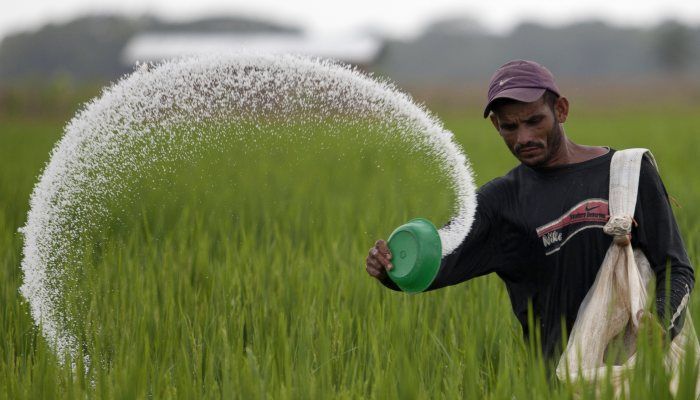Integrated fertilization management manual
Apply nutrients in a balanced and precise way is a requirement for the sustainable development of agriculture that produces food with the purpose of achieving food security. Specific soil and crop nutrition increases agricultural productivity ensuring maximum nutrient uptake by plants and therefore reducing losses in fertilization, which include emissions of nitrous oxide and other greenhouse gases.
Plants, for their healthy and productive growth, require seventeen essential elements: carbon (C), hydrogen (H), oxygen (O), nitrogen (N), phosphorus (P), potassium (K), sulfur (S), magnesium (Mg), calcium (Ca), iron (Fe), manganese (Mn), zinc (Zn), copper (Cu), boron (B), molybdenum (Mo), chlorine (Cl) and nickel (Ni). Furthermore, other elements such as sodium (Na), cobalt (Co) and silicon (Si), are also essential for the growth of some species.
Carbon, H and O are obtained from the atmosphere and water. The rest of the elements, according to their average concentrations in plants, can be divided into three groups: primary macronutrients (N, P and K), secondary macronutrients (S, Mg y Ca) y micronutrients (Fe, Mn, Zn, Cu, B, Mo, Cl y Ni).
If the availability of an essential element for plant nutrition is insufficient, the growth of these plants is limited and so are both the yields and the quality of the harvested products. The growth of the plants is limited by the essential element that is in less quantity below the level
optimal availability (Liebig minimum law, Fig.1)
–
Main sources of nutrients
Nutrients can come from various sources such as:
- The rock weathering It is a slow process of releasing small amounts of nutrients, insufficient to sustain medium or high yields over time.
- Previous applications of nutrients that have not been captured by previous crops that can either be lost to the environment or stored in the soil and potentially available for subsequent crops. Some elements such as N and S can present important losses in the year of application, mainly in conditions of high humidity. Nutrients such as P and K remain in the soils for prolonged periods, generally years, depending on the type of soil, frequency of fertilization and intensity of rainfall and management practices.
- The atmospheric deposition, mainly N and S, can be a significant contribution in some areas. In response to regulations to reduce S emissions to prevent acid rain, the contributions of this element have decreased and S has increased its limitation for the normal production of plants.
- Contributions from irrigation water containing some essential nutrients for crops.
- The crop residues, such as leaves, stems and roots when they are on or in the soil release the nutrients they contain (Table 1). These residues are mostly rich in K. However, when burned or used as food, their contributions decrease. Crop residues vary widely in the contents and amounts of nutrients available to plants that are released over time can be estimated mainly from local information.
- He animal manure it is a valuable source of nutrient fertilization whose composition varies widely according to sources (Table 1) and management practices. When feed quality is poor, manure contains few nutrients.

–
- The organic waste Decomposed (composting) can be added to soils to provide nutrients and contribute to its conditioning. The quality of composts can vary according to the materials and processes used (Table 1).
- The urban biological waste (biosolids) from household treatment water can be recycled and provide important nutrients for plants. The amounts of nutrients in biosolids, depending on their origins, treatment processes, storage and distribution, vary in quantity and forms. Regular analysis of its nutrient content and possible contaminants is convenient.
- The biological fixation of N (FBN) is the conversion of inert atmospheric N (N2) into forms of N that plants can use. BNF is found in numerous combinations of cultures and bacteria. It is higher in symbiotic systems developed between legumes (eg soybeans, peas, beans, alfalfa, peanuts, etc.) and rhizobia. The reported annual contributions per BNF vary between 20 and 400 kg of N / ha depending on the plant species, duration of the growing season and climatic conditions.
- Fertilizers made by the fertilizer industry and used for agricultural production, providing one or more essential elements available to plants. Fertilizers that contain only one nutrient are called “simple” fertilizers, while fertilizers with inputs of multiple nutrients can be both complex (all nutrients in the same granule or solution) or physical mixtures (mixture of different products). Each fertilizer product has its own benefits and disadvantages that depend on local or specific agro-ecological and economic conditions.
Efficient management of crop fertilization
In this manual of good fertilization management practices It seeks to abound on the guidelines integrated management in the fertilization of crops as an indispensable technology to achieve this end. Always, with a clear horizon, that of achieving profitable and sustainable production, through the promotion of adequate nutrient replacement and the preservation of soil resources.
–


